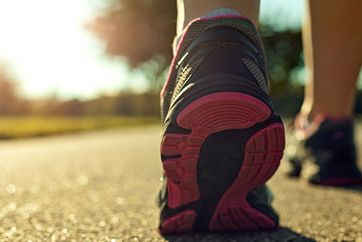Walking downhill after meals boosts bone health in postmenopausal women
NEW ORLEANS — A small cohort of postmenopausal women with type 2 diabetes who walked downhill within 1 hour after eating experienced a marked increase in a biomarker for bone formation, according to study data presented at the Endocrine Society annual meeting.

“Going uphill, intuitively, you would think that you work harder and that it is going to be more beneficial,” Katarina T. Borer, PhD, a professor emerita of kinesiology at the University of Michigan in Ann Arbor, said during a press conference. “Actually, you are unloading the bones because you are going against gravity.”
Menopause is associated with bone loss, and women with type 2 diabetes are more likely to experience a fracture vs. women without diabetes, Borer said.
“The combination [of menopause] with diabetes makes bone more vulnerable to breakage, even though many diabetic women are [obese], which is normally beneficial for bone,” Borer said.
Borer and colleagues analyzed data from 15 postmenopausal women with type 2 diabetes and overweight or obesity (mean age, 58 years; mean BMI, 27.2 kg/m²; mean diabetes duration, 10.8 years) who were randomly assigned to two 5-day interventions. All women consumed isocaloric meals consisting of 50% carbohydrates, 15% protein and 25% fat at 10 and 17 hours and then completed two daily, 40-minute exercise bouts on a treadmill at either 8 and 15 hours (2 hours before meals) or 11 and 18 hours (1 hour after meals), with some women assigned to walk downhill (6° slope; mean downhill speed, 47.9% maximal oxygen consumption [VO2 max]) and others assigned to walk uphill (6° slope). Researchers collected blood samples hourly between 8 and 20 hours and at 0 and 6 hours the next morning to measure markers of bone formation, including osteocalcin and C-terminal propeptide of type 1 collagen (CICP) and markers of bone resorption, including C-terminal telopeptide of type 1 collagen (CTX), anabolic growth hormone and catabolic cortisol level. Physical effort was assessed via VO2 max.
To measure mechanical loading, women wore mechanosensitive shoe insoles to measure peak ground reaction force, Borer said.
During the uphill trials, mean effort was 75.2% VO2 max and mean peak ground reaction force was 780.7 N. During downhill trials, mean effort was 47.9% VO2 max and mean peak ground reaction force was 1,104.8 N (P > .05 for both).
Researchers found that eating a meal uniformly suppressed CTX and variably increased CICP.
Exercise bouts on the treadmill before eating did not facilitate osteogenesis, Borer said; however, researchers observed changes in CTX and CICP in women who exercised after consuming meals, particularly after the first downhill bout. Mean CICP levels were 44% higher for women who completed a 1-hour exercise bout after consuming a meal at 10 hours vs. levels measured after the downhill exercise bout completed before the meal at 10 hours (area under the curve, 685.9 vs. 384.1 ng/mL per hour).
“So if you exercised before you ate, you were wasting your time,” Borer said.
Borer said when exercise is performed within 1 hour after eating, increased loading via a downhill treadmill bout produces a marked increase in osteogenic ratio after the first — but not the second — exercise bout, whereas increased energy expenditure with decreased mechanical loading, via an uphill treadmill bout, does so only after the second exercise bout.
“This is interesting because people don’t think postmenopausal bone is responsive,” Borer said. “The biggest outcome here was the suppression of the resorption marker, CTX.”

Borer said the timing of meals and exercise has a differential effect on osteogenic ratio between the marker of bone formation and resorption. When exercise is performed in a fasted or postabsorptive state, she said, it produces no osteogenic effect regardless of the mechanical loading.
“If you want to do something good about your bones, with or without supplemental medication, the best thing would be to exercise downhill about 1 hour after eating and get a big beneficial effect,” Borer said.
Such a regimen might be able to reduce the need for osteoporosis medication for some women; however, more studies are needed to assess how much exercise is needed to compensate for an antiosteoporosis therapy, Borer said. – by Regina Schaffer
Reference:
Borer KT. SUN-538. Presented at: The Endocrine Society Annual Meeting; March 23-26, 2019; New Orleans.
Disclosure: Borer reports no relevant financial disclosures.

